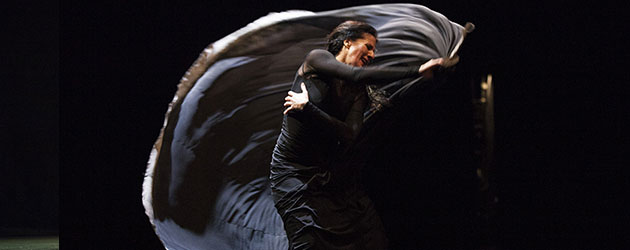Silvia Cruz Lapeña
Photos: Ana Palma
Voice: Ana Ramón, Juan de Mairena. Palmas: José Barrios. Guitar: Rubén Levaniegos. Cello: Sergio Menem. Violin: David Moñiz. Script: El Arbi El Harti.
Special 21 Festival de Jerez – All the information
A few years back, José Menese released “A mis soledades voy, de mis soledades vengo”, in which he went for the mystic approach, singing to Saint Theresa and Fray Luis de León. Enrique Morente also took that route with his flamenco mass, and a few months ago, Curro Piñana created a lovely trilogy that began with “Moradas Jondas”, where he too delved into Saint Theresa and the mystic sufi. All men and singers, just as it now seems to be the women who are inclined towards asceticism, or so it seems looking at the program of the Festival de Jerez where La Moneta presented Divino Humor Humano, Patricia Guerrero brought Catedral and last night it was the turn of María Pagés who presented Óyeme con los ojos, a show that takes its name from Sentimientos de Ausente, a poem written by Sister Juana Inés de la Cruz.
Pagés was brilliant. Simply brilliant. She shone with a delicate light, without making a fuss, which is her style; she has turned her body into a temple. She opened with martinete, and immediately there were mystical references, not only in her dancing, but also in the music, in the lighting and the wardrobe. That’s the difference between a true artist, and someone who merely dances. It’s the difference between one who knows how to choose who accompanies her, and someone who just takes anyone who pops up, or who charges the least. The cast: Ana Ramón and Juan de Mairena were exemplary in the singing, and all that was missing was greater vocalization, because even though flamenco is expression, the poems of Rumí, Fray Luis de León and San Juan de la Cruz are worth listening to. The guitar of Rubén Levaniegos was also excellent, as was the cello of Sergio Menem, and the surprising violin of David Moñiz, whose technique was amazing.
In the siguiriya, the red bata de cola seemed to be made of flames more than ruffles, and at times Pagés looked like a Bernini sculpture, in the style of Éxtasis of Saint Theresa, where the dress served as a base that bound her to the floor. She danced from the waist up, and her movements of head, shoulders and hands were an amazing display of technique and elegance. But not that stylized boring elegance we sometimes see on stage where the person dancing is just looking for the right pose for a good photo, or a beautiful gesture. María was eloquent with her arms, which she does not treat as privileged appendices, but as tools of communication which last night she used to express her monologue.
“I shan’t pick flowers / nor hunt the beasts / and I shall pass forts and frontiers”, sang Ana Ramón to San Juan de la Cruz in a fandango facing-off with Juan de Mairena with her voice full of flamenco quality, both putting the singing level for backup singers high in this festival, very very high. Then Pagés came out, and instead of dancing, she recited. She did Palabras para Julia of José Agustín Goytisolo, who, though perhaps not a mystic in the classic sense, through his words, dedicated to the daughter, true enough, but also to the future, brought out the actress in Pagés who recited with great emotion and prepared herself for tientos tangos. With that, the title of the work was recuperated, she clung to the rhymes of Sister Juana Inés, and with “Óyeme con tus entrañas”, she danced gaily, happily, smiling and impetuously, free of the floor, aspiring to the heavens.
What came afterwards was a surprise. María, in a short dress and with a fan, sang “Ay qué calor”, a light-hearted number in which the entire group took part, with verses far removed from mysticism and straight from the street, because in the end, marriage, and the daily chores of living are sung by María and Ana Ramón with plenty of charm. It felt like a fiesta finale, but it wasn’t. The end brought an even better surprise: María with granaínas, sheathed in a black and grey veil/dress, wafting and at times transparent, with which she put movement to some wonderful verses of her husband’s, El Arbi El Harti, who was also responsible for the script: “Let’s go to the shade of the shadows / I want to touch your hair”.
And with those words of a love more carnal than mystical, María slipped away amidst curtains and ended her monologue. This is the first time in her career Pagés has danced without her company, and the decision makes sense: to think who we are, where we’re headed or what we believe in are things that can only be done through soul-searching within oneself. The difference between you and her, is that Pagés has doubts, and she answers them dancing. And how she dances!
Photo gallery María Pagés, by Ana Palma
